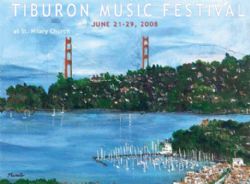|
Symphony
FROM THE NEW WORLD TO THE OLD WORLD
by Peter Lert
Saturday, June 14, 2025
Chamber
MC2 DUO RECITAL CLOSES 222'S SEASON
by Terry McNeill
Saturday, June 14, 2025
Choral and Vocal
CANTIAMO SONOMA'S LUSCIOUS A CAPELLA SINGING IN SEASON ENDING CONCERT
by Pamela Hicks Gailey
Sunday, June 8, 2025
Symphony
SRS SEASON ENDS WITH RESOUNDING TA-TA-TA-BANG
by Terry McNeill
Sunday, June 1, 2025
Symphony
YOUTHFUL VIRTUOSITY ON DISPLAY AT USO'S MAY CONCERTS
by Peter Lert
Saturday, May 17, 2025
Symphony
MYSTICAL PLANETS AND LIVELY GERSHWIN ORTIZ AT FINAL SRS CONCERT
by Peter Lert
Sunday, May 4, 2025
Symphony
VSO'S CONCERT MUSIC OF TIME, MUSIC OF PLACE
by Peter Lert
Sunday, April 27, 2025
VOCAL ELEGANCE AND FIRE AT THE 222'S RECITAL APRIL 26
by Pamela Hicks Gailey
Saturday, April 26, 2025
CANTIAMO SONOMA SINGS AN INSPIRED GOOD FRIDAY MOZART REQUIEM CONCERT
by Pamela Hicks Gailey
Friday, April 18, 2025
DRAMATIC SHOSTAKOVICH SYMPHONY CLOSES PHILHARMONIC'S 25TH SEASON
by Terry McNeill
Sunday, April 13, 2025
|
 |
AN ORCHESTRAL SEXTET
by Terry McNeill
Saturday, June 28, 2008
On paper, the closing concert of the Tiburon Music Festival June 28 seemed a chancy venture. Two well-known piano concertos were to be performed with a soloist and an orchestra of just five string players. No winds, brass or percussion, no weight in the sections to produce mighty sound to honor the mighty Haydn and Beethoven.
The musical results? Impressive, convincing in their own way, but giving no great desire to displace the originals.
The final event of seven-concert Festival, all at St. Hilary Church, attracted 200 people, many curious to hear how Beethoven’s magisterial G Major Concerto, Op. 58, would unfold with minimal forces. Festival Director Paul Smith conducted from the piano with sparse hand gestures and head movements replacing a conductor’s baton. The simple opening statement from the piano set a dignified reference point and a slow tempo, both continuing until the sublime Andante con Moto. String pitch problems quickly settled down, and the low cello and bass frequencies were strong enough to cover the two violins and viola. The bright church acoustics favor these frequencies, and added much to the volume of bowed-string sound. Paul Rhodes played an elegant and sonorous cello line throughout, and had short but lush duos with Mr. Smith. The piano plays with the strings in places not heard in the original c. 1806 Concerto, and the cadenza was not wholly Beethoven, or even the Reinecke, which was once popular. It’s slightly jarring, but not at all irritating, to hear such a masterwork played this way. Mr. Smith’s trills, expressive and often very fast, were telling all evening.
The second movement was inspiring, each instrument carefully balancing the somber nature of the music, and the opening of the concluding Rondo-Vivace was a call to arms. Here the usual heft in the strings was missed, but the group’s focus was the interplay of question and answer, cello to piano, piano to Pamela Carey’s lead violin, sforzandos snapping. The shortened cadenza was mostly Beethoven, but perhaps something of Mr. Smith also? The ending had authority, and generated a standing ovation.
In the first half, the ensemble played Aulis Sallinen’s 1997 Introduction and Tango Overture, a less-than-ten minute exploration of powerful rhythmic possibilities. The introduction was somber, strident dissonances relaxing into atmospheric chorales. The Tango finally came, but it was far from the tango of the Argentinean bandoneon. The insistent rhythms here were performed for dramatic rather than seductive effect, and the unexpected ending was pungent. Wonderful stuff for a piano sextet, and there isn’t too much heard for this combination, past the Chausson Concerto, Op. 21, and the Mendelssohn Sextet. I vote for the Chausson next year.
Preceding the Sallinen and providing sharp contrast for the Beethoven was Haydn’s D Major Concerto, here again with the resident Sextet. Mr. Smith spoke to the audience about the provenance of the score reductions, and that transparent textures are mandatory. Playing frequently with the shift pedal, Mr. Smith led a taut performance, pushing the pace that often just had the strings arriving together at phrase endings. There is much Mozart in the Un Poco Adagio, with the upward progressions equally shared, and a short keyboard trill leading to the final Rondo. Here the many modulations brought variety to the music, the fast scales from the piano occasionally indistinct but always well integrated with the strings. Haydn’s most popular piano concerto, from about 1781, was gracefully served.
One would be remiss by not mentioning details which made the initial Tiburon Festival an event of substance – many works of Marin composers, performers from the SF Bay area, signature posters and wine labels, a sparkling facility and generous supplies of excellent gratis hors d’oeuvres. It was exotic to encounter oysters as intermission fare. I hope these happy traditions continue in next June’s Festival.
|

